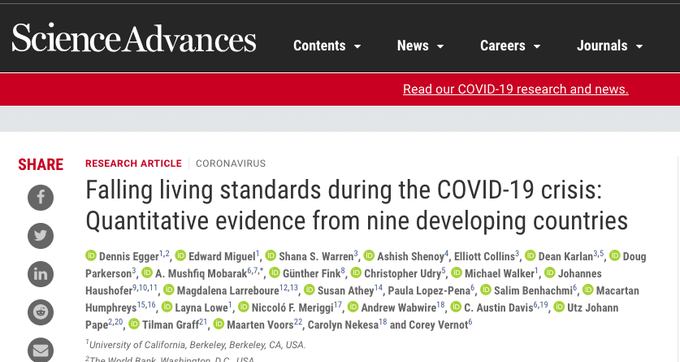🚨 Important new paper just out in Science Advances: What were the effects of 2020 COVID lockdowns and disruptions on households in lower income countries?
(From 26 co-authors on 3 continents!)
Summary/brief:
Full Paper:
4
98
179
Replies
In spring of 2020, countries all over were shutting down borders and markets, taking COVID mitigation measures, and telling people to stay home - but how did this affect people in lower-income countries? And how could we find out with face-to-face survey research suspended?
1
0
1
Researchers joined together, quickly pivoting to phone surveys, w/past & ongoing samples and getting new representative ones with random digit dialing, they surveyed 30,000 households in Bangladesh, Burkina Faso, Colombia, Ghana, Kenya, Nepal, Philippines, Rwanda, & Sierra Leone
1
0
4
Everywhere they found drops in income and employment: 50-80% of samples from Bangladesh, Burkina Faso, Colombia, Ghana, Kenya, Rwanda, and Sierra Leone
1
1
4
By April, many households didn't have enough food. 48% of rural Kenyan households, 69% of landless agricultural households in Bangladesh, and 87% of rural households sampled in Sierra Leone were forced to miss meals or reduce portion sizes
1
4
3
In most countries, a large share of respondents reported reduced access to markets, during lockdowns & other mobility restrictions implemented between March and June 2020.
1
0
1
Where there is data, firm revenue & profits were approximately halved during the first months of the COVID-19 crisis. There was also a pronounced decline in household expenditures - they appear to have been be cutting back non-food spending in order to have enough to eat
1
2
6
Data were given to policymakers in countries quickly last year, but are also important as the global community talks about fighting COVID and limiting spread of new variants. Existing safety nets & NGO aid wasn’t enough to compensate for the losses in poorer countries.
1
0
1
Many many people across lots of orgs (inc
@IGC_SierraLeone
@Yalerise
@BusaraCenter
Vyxer Remit Kenya
@CEGA_UC
) worked together on this, staying up all night, learning new phone survey methods in days, hearing difficult stories, all while dealing w/the pandemic themselves.
1
0
2
And the many co-authors! (in no particular order)
@EggerDennis
,
@CarolNekesa5
,
@tedmiguel
,
@mwwalkerecon
,
@lslowe5
,
@deankarlan
,
@chrisudry
,
@mushfiq_econ
,
@caustindavis
,
@PaulaLopezPena2
,
@guenther_fink
,
@mlarreboure
,
@jhaushofer
,
@Susan_Athey
,
@maqartan
,
@nmeriggi
1
0
7
@caustindavis
,
@utzjpape
,
@TilmanGraff
,
@elliottmcollins
,
@ShanaS_Warren
,
@DougParkerson
,
@corey_vernot
, Maarten Voors, Ashish Shenoy!
1
0
2
@poverty_action
@_georgeperry
Very insightful. Is the data available for other research to use? Thanks
1
1
4
@poverty_action
Great insights on the effects of C-19, brings out the startling situation in rural areas which haven't been a priority area interest for short-term humanitarian relief mainly due to resource limitations.
Is there a detailed Kenya-specific analysis? I'd be happy to have it.
1
1
0






